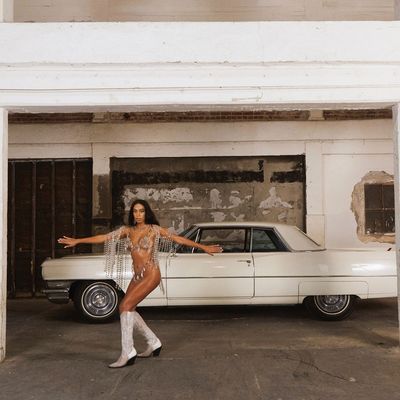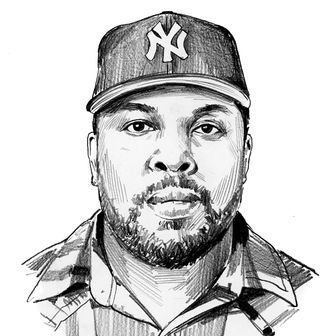
Solange is world-building. Over the last three years, the Houston singer, songwriter, producer, and artist has worked quietly and intensely on a series of projects across mediums whose purpose seems to be to envision the peace and order the real world lacks. Her 2016 studio album, A Seat at the Table, and “Orion’s Rise,” a visually stimulating live production presented to select theaters the following summer, provided comfort food for the election-addled masses. Her stint as the face of the 2017 Michael Kors street-style campaign was a blend of accessibility, storybook beauty, and metropolitan sophistication. The same year’s Calvin Klein digital holiday campaign dressed the singer in denim alongside friends and musical collaborators in a barn, as a meditation on the concepts of family and Americana. Last year’s Hammer Museum performance piece “Metatronia (Metatron’s Cube)” used music, interpretive dance, and sculpture to create “charge through visual storytelling.” This month’s new visual album When I Get Home unites these interdisciplinary exercises like a lodestone. Solange is creating a beautiful Black America of the mind, imagining how far we would get in a society unencumbered by division and disorder.
It’s not a new idea. Afrofuturist works, from Sun Ra’s Space Is the Place film and album, through director Ryan Coogler’s Academy Award–winning comic-book adaptation Black Panther, have grappled with the question of what black life would look like loosed from the shackles of American history. Earth, Wind, and Fire album art toyed with it, as did the black android iconography of Janelle Monáe’s Metropolis series. When I Get Home doesn’t share its predecessors’ interest in escapism or hermetic seclusion, though. It’s an act of reclamation. It elevates art from our real past and present by appreciating it without stigma. In the world of When I Get Home, parking-lot parties and pole dancing and grills and Screw tapes and twerk videos aren’t low culture. They’re just as important to the through line of American history as any of the aging scrolls, wigs, and tricornered hats gathering dust in our museums. Home wants you to know about black cowboys and black sculptors and black dancers and black inventors. (The album was teased in a revival of the social-network site Black Planet, one of the early Web 2.0 precursors to Twitter.)
By juxtaposing Texas street culture with interpretive dance and brutalist architecture, by staging dance sequences with visual nods to both Alvin Ailey’s “Revelations” and Frank Ocean’s “Nikes,” Solange seems to be asking why art made by and for working-class people is viewed through a different lens than art that lives in expensive homes and galleries. Presenting Home as an exclusively black planet suggests that these distinctions aren’t our fault, that popular perceptions of what is and isn’t classy are borne out of hundreds of years of sternly enforced inequality. Stereotypes about the kinds of food we eat and the style of music we enjoy are rooted in restrictions on what black shoppers and vendors were allowed to buy and sell in the Jim Crow years. These divisions animate our present as much as our past. When I Get Home is a Carrollian trip down a rabbit hole where none of that stuff happened. It’s a lucid dream about freedom.
When I Get Home’s music pursues the same aims. It honors the history of Houston hip-hop by using it as a vehicle for a voyage into strange locales. It flows like a production by DJ Screw, full of familiar sounds warped into barely recognizable forms. It also moves like ’70s jazz and New Age records and ’60s processed tape compositions. The synths feel unpredictable and alive. The words tumble out in evocative phrases and collide in disorienting repetitions. They float as dreamlike sequences of comforting images. It might come as a shock to the audience of listeners who felt like A Seat at the Table gave powerful voice to their frustrations to hear Solange waxing exotic on “Dreams” (“I grew up / A little girl / With dreams, dreams, dreams, dreams, dreams, dreams”) or “Almeda” (“Pour my drank, drank, sip, sip, sip, sip, sip”). She’s telling stories without storytelling, expressing selfhood as a pure ray of being, like Sonny and Linda Sharrock’s soulful, wordless, sublime “Black Woman.”
There are people bound to shut the record off and demand to know where the traditional songs are. When I Get Home — like a growing list of modern indie rap, soul, and jazz records, including the latest works by Earl Sweatshirt and Standing on the Corner, who contribute here alongside a veritable Justice League of movers and shakers in modern black music — is here to challenge your perception of what a song can be. Hip-hop heads of a certain age will find it scratches the same itch Doom and Madlib’s Madvillainy did. Both albums are offbeat structures made from short, evocative song fragments. Fans of weirder stuff will hear shades of Todd Rundgren’s A Wizard, A True Star, itself a woozy, psychedelic tribute to the back end of the Beatles’ Abbey Road, where Lennon and McCartney bounced quick sketches off each other to brilliant effect. The seamless sequencing is also reminiscent of Solange’s Texas-soul elder, Erykah Badu, whose 2000 album Mama’s Gun unfurled as a playlist that didn’t really stop between tracks. This music is offbeat, but not without precedent. It’s strange, but never forbiddingly so.
Solange noted in a chat about the album in Houston on Sunday that she was listening to Steve Reich, Alice Coltrane, and Stevie Wonder’s Journey Through “The Secret Life of Plants” as she coached and edited the open-ended jam sessions that birthed the music for the new album. The Stevie parallel is almost too rich. Released after 1976’s Songs in the Key of Life to accompany a film full of time-lapse photography and suggestions that just maybe flowers have feelings, Plants is the spot in Wonder’s nearly flawless ’70s creative streak that people rarely talk about. Reviews suggested it was difficult or else half-baked, the bridge too far in a decade of innovations; Stevie reined himself in and returned a little under a year later with the crisp, funky Hotter Than July.
When I Get Home is most certainly not Solange’s Life of Plants. It isn’t a detour or an experiment. It isn’t the past being mirrored or repeated. It feels like something entirely new is happening. It feels like the themes Solange has been exploring outside of her music are finally trickling down into it. (Compartmentalizing is work. “Can I Hold the Mic” spells it out: “I can’t be a singular expression of myself, there’s too many parts, too many spaces, too many manifestations …”) When I Get Home is hip-hop that doesn’t tell you what to think. It’s soul music that doesn’t tell you what to feel. It’s the answer to the old Funkadelic question: “Who says a jazz band can’t play dance music?”


